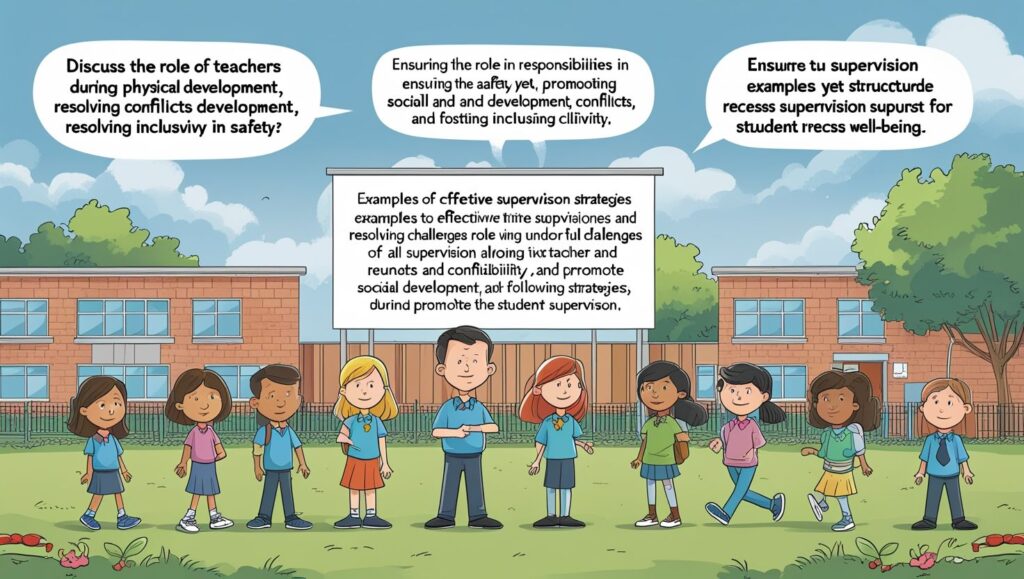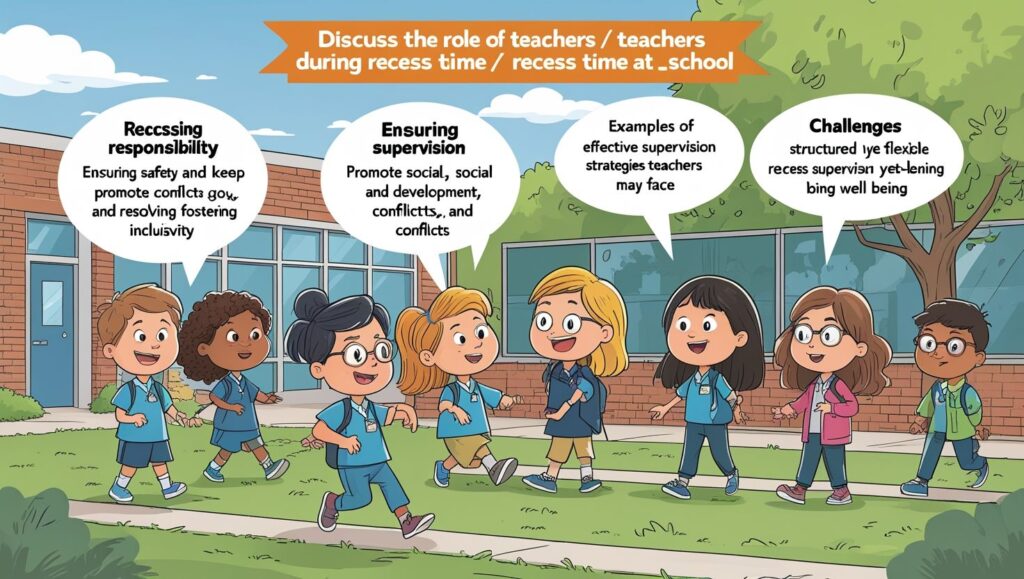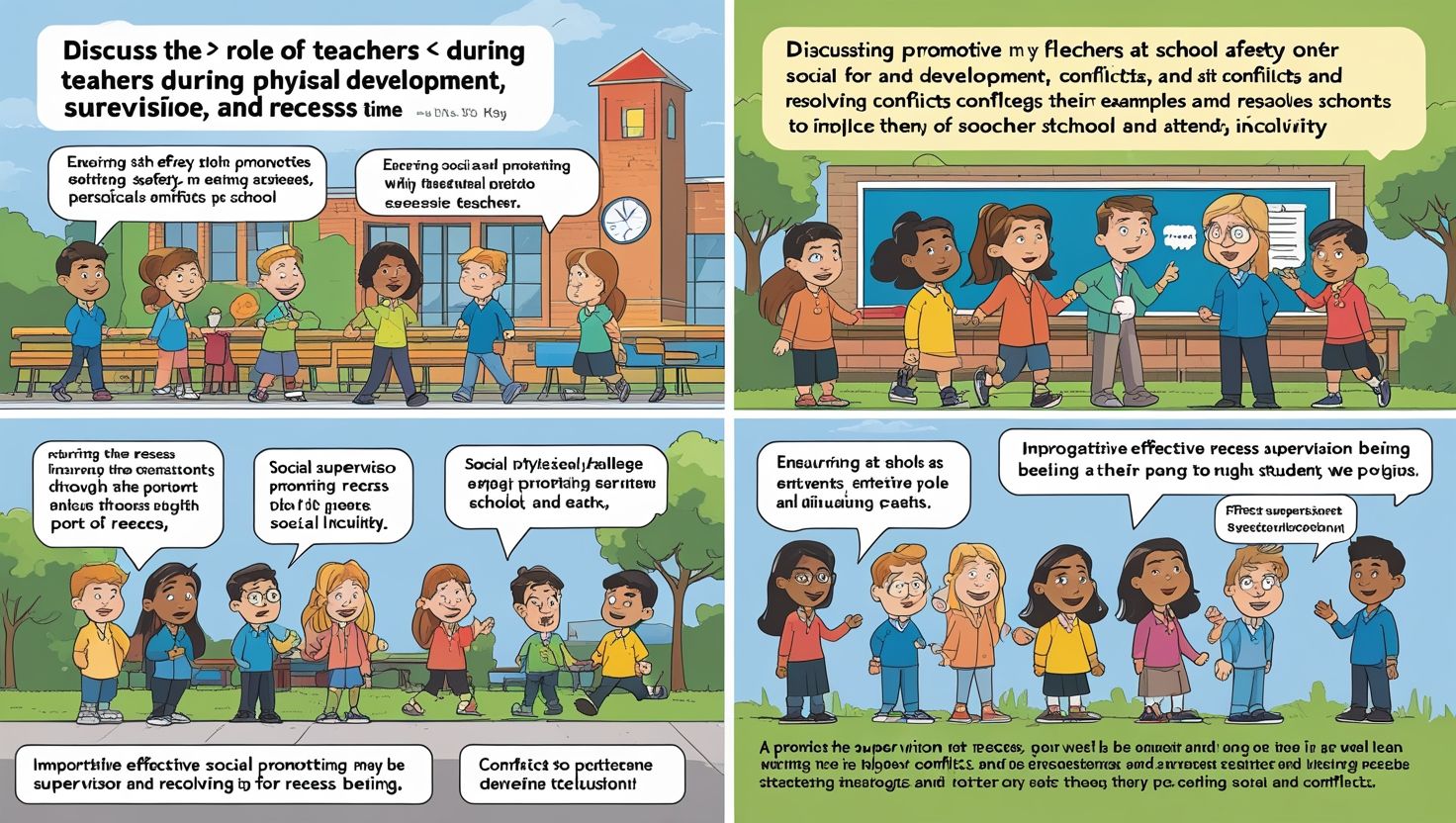Introduction
The Role of Teachers During Recess Time at School, The role of teachers during recess time is crucial in ensuring a safe, structured, and enriching environment for students. Recess is not just a break from academics but also a vital part of a child’s social, emotional, and physical development. Teachers play a significant role in supervising, mediating conflicts, encouraging positive play, and fostering an inclusive atmosphere. This article explores the responsibilities of teachers during recess, the challenges they face, and strategies to maximize the benefits of recess for students.
Background
Recess is an essential part of the school day, providing children with opportunities for unstructured play, social interaction, and physical activity. Research shows that recess contributes to improved concentration, reduced stress, and better classroom behavior (Pellegrini & Bohn, 2005). However, without proper supervision and guidance, recess can also become a time for bullying, exclusion, or injuries.
Teachers are often the primary supervisors during recess, though some schools employ playground monitors or aides. Regardless of who oversees recess, teachers have a unique understanding of their students’ social dynamics and behavioral tendencies, making their involvement critical. Their role extends beyond supervision—they must also facilitate positive interactions, model conflict resolution, and ensure that recess remains a productive and enjoyable experience for all students.

Main Ideas
1. Supervision and Safety
The primary responsibility of teachers during recess is to ensure student safety. This includes:
- Monitoring play areas to prevent accidents.
- Enforcing school rules (e.g., no pushing, staying within boundaries).
- Being vigilant for signs of bullying or exclusion.
Example: A teacher notices a group of students playing near a slippery area after rain and redirects them to a safer spot to prevent falls.
2. Conflict Resolution
Recess can lead to disputes over games, sharing, or inclusion. Teachers should:
- Mediate disagreements calmly.
- Teach students problem-solving skills.
- Encourage fair play and sportsmanship.
Example: Two students argue over who gets to use the jump rope first. The teacher helps them negotiate taking turns rather than imposing a solution.
3. Encouraging Inclusive Play
Some students struggle to join games or may feel left out. Teachers can:
- Suggest group activities that involve everyone.
- Pair shy students with friendly peers.
- Introduce structured games that promote teamwork.
Example: A teacher organizes a simple relay race, ensuring all students participate regardless of skill level.
4. Promoting Physical and Social Development
Recess is an opportunity for children to develop motor skills and social competence. Teachers can:
- Introduce new games that require cooperation.
- Encourage students to try different activities (e.g., skipping, climbing).
- Observe social interactions to identify students who may need support.
Example: A teacher notices a student always sitting alone and gently encourages them to join a game of tag with classmates.
5. Balancing Freedom and Structure
While recess should be unstructured, some students benefit from guided activities. Teachers can:
- Offer optional games (e.g., four-square, hopscotch).
- Allow free play while stepping in only when necessary.
- Recognize when to intervene and when to let students resolve issues independently.
Example: A teacher sets up a drawing station for students who prefer quiet activities over running games.

Challenges Faced by Teachers During Recess
- Large Student-to-Teacher Ratios: Supervising dozens of children alone can be difficult.
- Behavioral Issues: Some students may act out when unsupervised.
- Weather and Space Constraints: Limited indoor spaces during bad weather can lead to chaos.
- Balancing Discipline and Fun: Teachers must enforce rules without making recess feel restrictive.
Strategies for Effective Recess Supervision
- Rotating Supervision Duties: Sharing responsibilities among staff prevents burnout.
- Training in Playground Management: Workshops on conflict resolution and game facilitation can help.
- Student Leadership Roles: Older students can assist in organizing games.
- Clear Rules and Expectations: Posting recess guidelines helps students understand boundaries.
References
- Pellegrini, A. D., & Bohn, C. M. (2005). “The Role of Recess in Children’s Cognitive Performance and School Adjustment.” Educational Researcher, 34(1), 13-19.
- Jarrett, O. S. (2013). “A Research-Based Case for Recess.” US Play Coalition.
- American Academy of Pediatrics. (2013). “The Crucial Role of Recess in School.” Pediatrics, 131(1), 183-188.
Conclusion
Teachers play a multifaceted role during recess, ensuring safety, fostering social skills, and promoting an inclusive environment. By actively supervising, mediating conflicts, and encouraging positive play, teachers help make recess a valuable part of the school day. Schools should support teachers with proper training and resources to maximize the benefits of recess for all students.
Key Questions for Further Discussion
- How can schools better equip teachers for effective recess supervision?
- What are the long-term effects of well-supervised recess on student behavior?
- How can teachers balance structured activities with free play?
- What role should students play in managing their own recess time?
- How does recess supervision differ across age groups (elementary vs. middle school)?
Addressing these questions and refining recess policies, schools can ensure that recess remains a positive and developmental experience for every student.

manavgat escort bayan Manavgat side escort bayanlarla daha önce yaşamadığınız seks fantezilerini birlikte yaşayın. Ayrıca biri birinden güzel Türk, Yabancı, sarışın Rus bayanlarla https://muabanotocu.org/
Greetings from Colorado! I’m bored at work so I decided to browse your site on my iphone
during lunch break. I enjoy the info you provide here andd can’t wait to tame a look
when I get home. I’m shocked at how quick your blog
loaded on my phone .. I’mnoteven using WIFI, just 3G ..
Anyhow, awesome site! https://hallofgodsinglassi.wordpress.com/